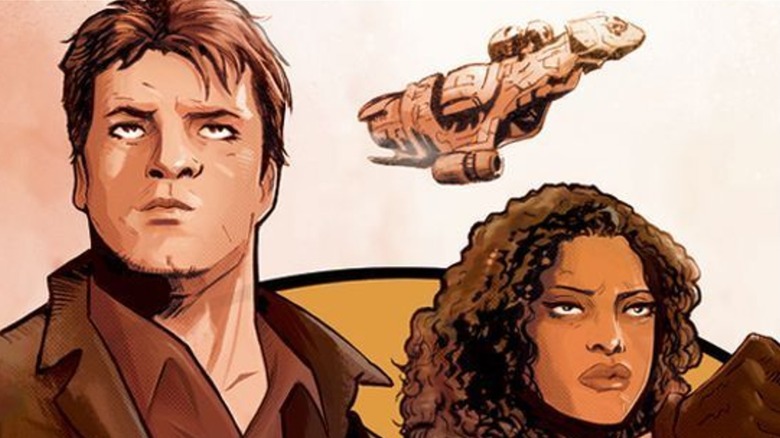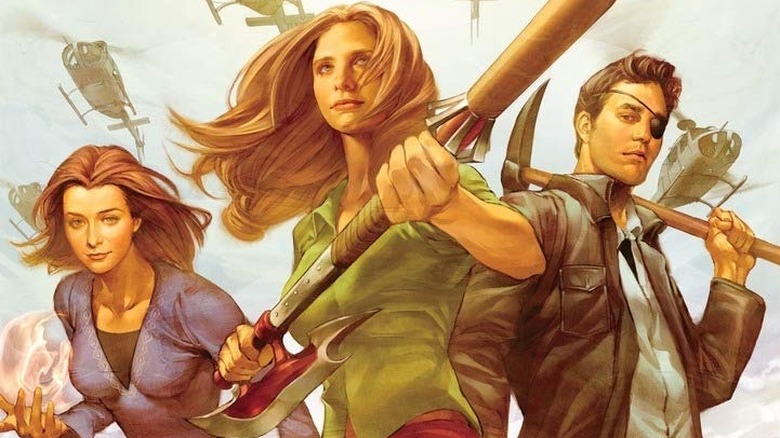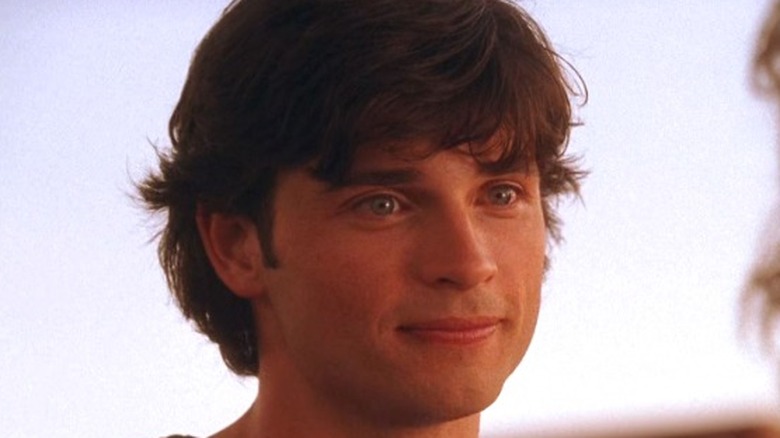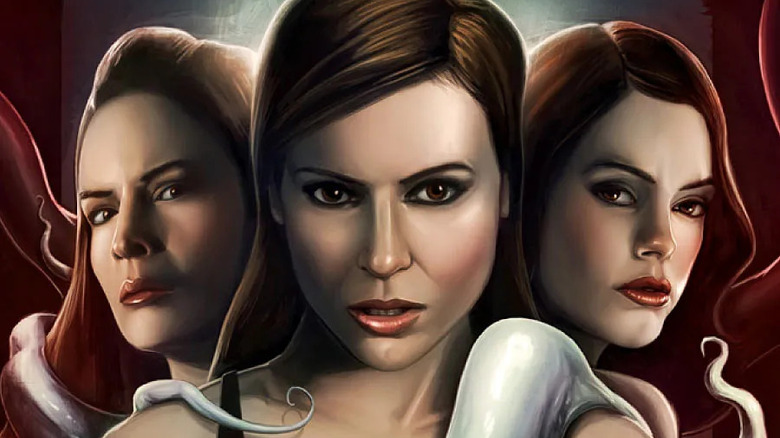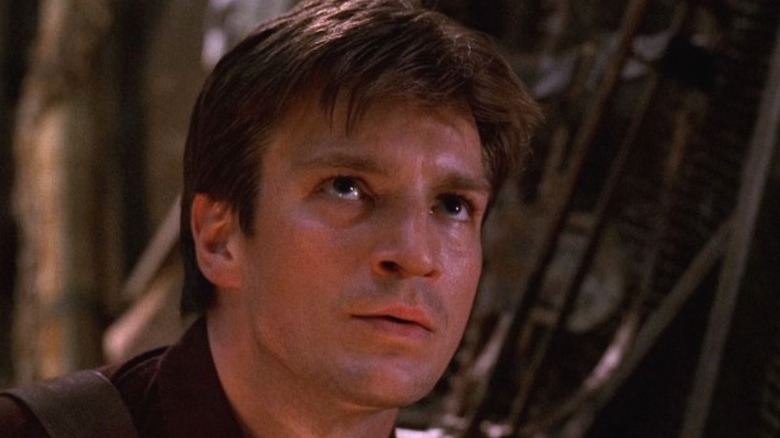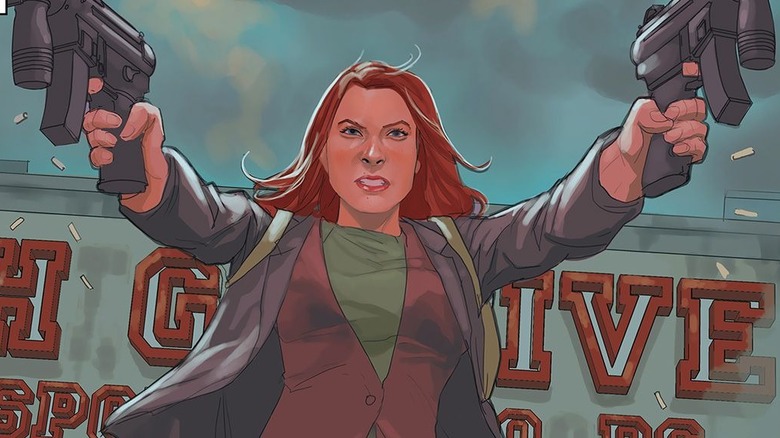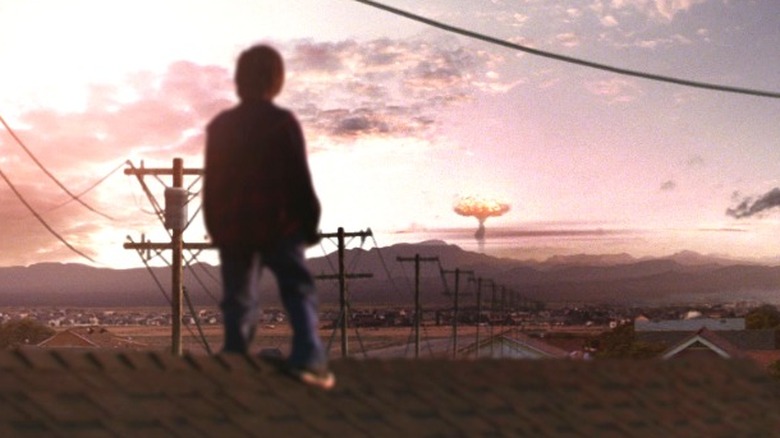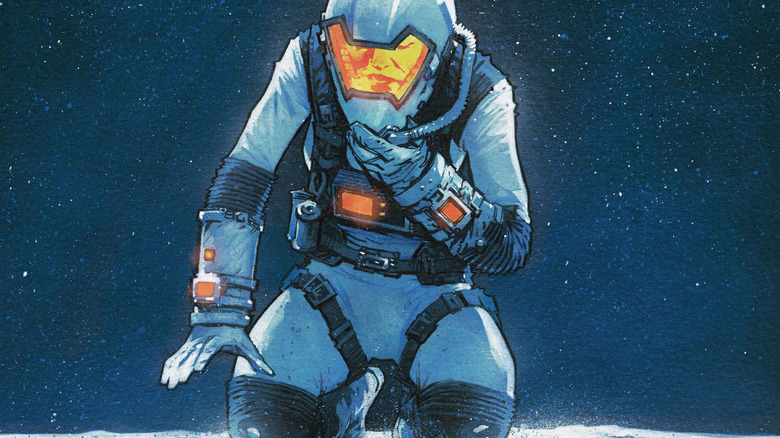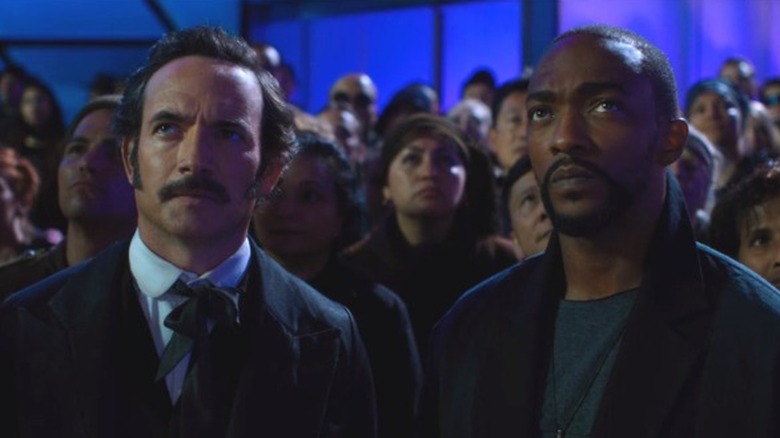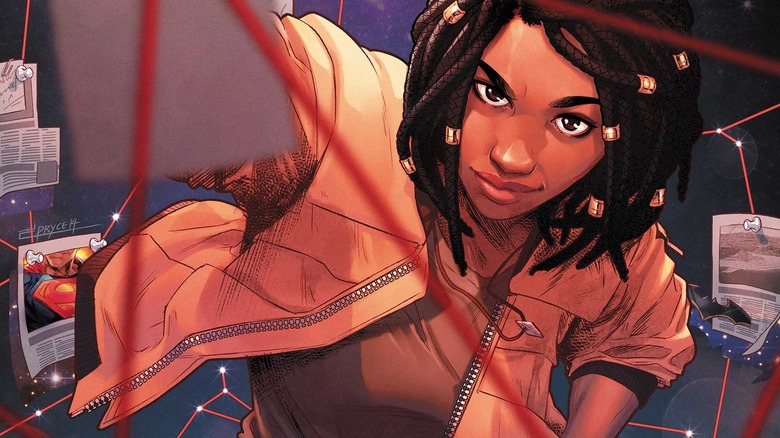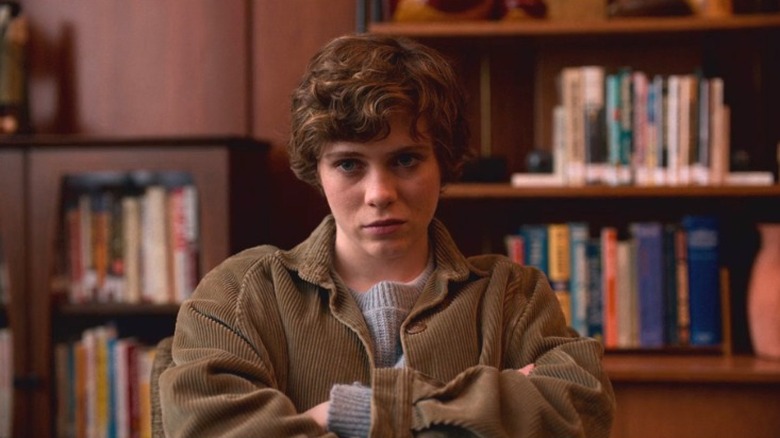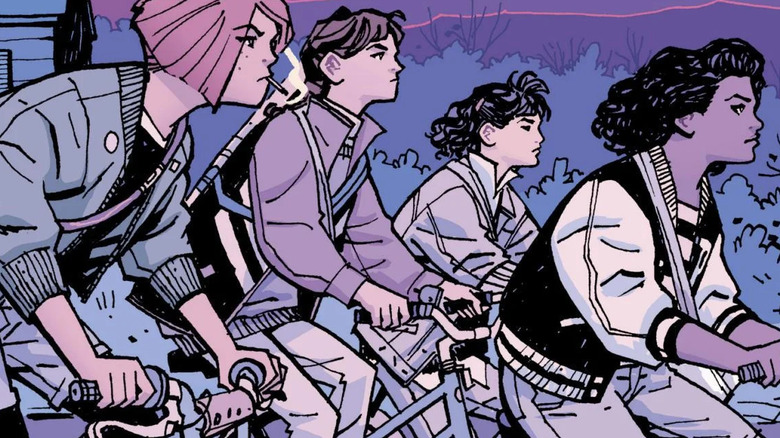Canceled Shows That Continued Their Story In Comics
Networks have always been on the lookout for new and innovative ideas for TV series. Recently, streaming services have shown that they are willing to look into fresh ideas and adapt stories from comics and novels into their next high-budget series. Regardless of whether we are talking about the '90s, 2000s, or present-day streaming wars, the competition for audience attention and a limited budget means that a lot of well-received shows are canceled. Series like "Charmed," "Firefly," and "I Am Not Okay with This," stopped production comparatively early despite gaining an audience and the respect of critics.
Luckily, fans can continue to enjoy some of their favorite TV stories in comic books even after their shows have stopped airing. From cancellations that prevented shows from telling the complete story of the comics they were based on like "Paper Girls," and "Naomi" to additional seasons for classic series like "Buffy the Vampire Slayer" and "Smallville" released as graphic novels, and books that continue critically acclaimed but canceled productions such as "The Expanse," and "Altered Carbon," here are some great canceled shows that continue their stories in comics.
Buffy: The Vampire Slayer (1997)
Probably one of the most popular TV series to come out of the 1990s, "Buffy: The Vampire Slayer" became not just a hit, but highly influential. While many more traditional teen-focused dramas are basically about the main characters starting and ending romantic relationships with each other while also touching on real-life issues, "Buffy" broke the cycle.
The brainchild of the eventual writer-director of 2012's "The Avengers" Joss Whedon, "Buffy" melds horror genre tropes with its teen melodrama, strikes a perfect balance between episodic plots and serialized stories, and reenergized female-driven stories (via Vox). Without "Buffy," we might not have light-hearted moments between the Winchester brothers in "Supernatural" or a dance number in "The Boys."
The series was popular enough to last seven seasons, and even launch a spin-off series in "Angel." But this wasn't enough for viewers who had developed a strong attachment to the characters and their adventures. To their relief, Whedon co-wrote a 40-issue series titled "Buffy: The Vampire Slayer Season Eight." The comics continue the adventures of Buffy and her "Scooby gang" of friends and allies while adding new characters. Whedon and other writers released a total of five additional seasons, as well as a successful reboot series, giving loyal fans many years of post-show fun.
Smallville (2001)
In the early 2000s, Superman had been a consistent presence on television for about a decade. Fans could watch animated shows like "Justice League" or "Superman: The Animated Series," and "Lois & Clark: The New Adventures of Superman" which ended in 1997 after four seasons on network TV. In 2001, however, The WB took the Man of Steel in a new direction. "Smallville" focuses on Clark Kent's high school years when he is still learning about his powers and hasn't yet taken on the Superman persona. The show, featuring Tom Welling in the role of Clark Kent, Michael Rosenbaum as Lex Luthor, and Kristin Kreuk playing Lana Lang, was a hit among both fans and critics, lasting 10 seasons and getting a compelling ending that saw Tom Welling finally wear the suit.
While the show was on the air, script coordinator Clint Carpenter wrote a series of comics that served as a companion to the TV show. As he explained in an interview with CBR, the issues were designed to expand on the story and further explain endings and cliffhangers. The project only lasted a few issues, but in 2012, Bryan Q. Miller, who worked as a story editor for the show, wrote a comic series titled "Smallville: Season 11." In the series, Clark fights crime and supervillains in Metropolis, but also teams with classic DC characters like Green Lantern, Batman, and Wonder Woman. Season 11 ends with the story arc "Continuity" — an adaptation of the classic DC comic event "Crisis on Infinite Earths," that brings the entire "Smallville" timeline to a close.
Charmed (1998)
With an original take on fighting supernatural threats that focuses on the bond between three witchcraft-practicing sisters, "Charmed" managed to captivate a loyal group of fans that kept the show alive for eight seasons. Famously, problems developed behind the scenes between the stars. The relationship between Alyssa Milano and Shannen Doherty, for example, was so tense that it led to the exit of the latter. In an ironic move, Doherty herself directed the episode where her character is killed off. Rose McGowan would take her place as a long-lost sister to maintain the mystical Power of Three that gives them their supernatural abilities.
Sadly, despite its loyal following, "Charmed" ended on Season 8. While a handful of spin-off ideas made it to various stages of development without seeing broadcast and a reboot was released in 2018, the continuation of the story for the original Halliwell sisters came in the form of a comic series published by Zenescope Entertainment.
"Charmed: Season 9" and "Charmed: Season 10" follow the story of the sisters reuniting with the now resurrected Prue (Shannen Doherty's character) and fighting The Source once again. The comics offer fans a chance to see the characters finally reunited. The popularity of the comics prompted another series by Dynamite Entertainment.
Firefly (2002)
Despite only lasting one season, Joss Whedon's ensemble cast sci-fi Western series had a profound impact on many of its viewers, creating a loyal community of devoted followers. The fact that it was never greenlit for a Season 2 (in fact, "Firefly" didn't even finish airing Season 1) was a devastating blow that fans learned to accept as the years went by. They would have to wait until 2005 to enjoy the adventures of the "Firefly" crew in "Serenity," a film that didn't perform well enough to generate the necessary interest to get another season or movie.
Fans have been able to continue the story in several comics miniseries of the same name written by Joss Whedon and other collaborators that feature the adventures of the ships' crew. Thank goodness for comics, because the odds of "Firefly" getting a TV reboot don't seem likely. Whedon's reputation has taken a beating over the last few years due to allegations of unprofessional behavior, and while online rumors of a "Firefly" relaunch on Disney+ relaunch circulated at one point, no announcements about such a project have emerged.
Dollhouse (2009)
Years before "Westworld" dove into the complex morals of manipulating human identity, Joss Whedon's "Dollhouse" explored a world where human minds could be rewritten for any purpose for the right price. In the series, Eliza Dushku plays Echo — a woman who has allowed a mysterious company to erase her memory and use her body for different tasks assigned by high-paying customers for a certain period of time. But Echo soon starts to remember who she is and discovers the flaws in both the technology and the morals of the Dollhouse. The premise is darker than most of Whedon's shows, as it explores topics such as sexual exploitation, corporate greed, and inequality. Unfortunately, "Dollhouse" only completed two seasons before its cancellation.
As Slant Magazine argues, "Dollhouse" represents Whedon's first attempt at taking on the topic of the dangers of corporate greed. As expected, in a world where technology can turn people into mindless puppets for the rich and powerful, the series ends in a cyberpunk dystopia where this potential is fully realized. The story continues in a one-shot comic named "Dollhouse: Epitaphs" that follows secondary characters Mag and Griff as they deal with humanity's collapse brought on by Dollhouse technology. Later, a five-issue miniseries emerged that adds Alpha, a character revealed to be a serial killer during the original airing of the TV show, to the comics cast.
Jericho (2006)
A gripping story set in a world where most American cities have been devastated by nuclear attacks and small towns are left to fend for themselves, the appeal of "Jericho" resides in the human conflict that sparks from its post-apocalyptic setting. Low ratings forced CBS to cancel the show, but network executives reconsidered after a massive online movement sent them 20 tons of nuts — a reference to a quote from the series. Noticing how loyal the "Jericho" fan community was, CBS brought the show back for eight episodes. Even though Season 2 does an acceptable job solving most of the show's plots, especially considering the small amount of time writers had to work with, the ending left many fans rather dissatisfied.
The number of people asking for a new season might not have been enough to kickstart a TV production, but it was enough to capture the attention of the comic industry. After the show ended, Devil's Due Publishing, and later IDW Publishing, released a six-issue miniseries titled "Jericho: Season 3." The comics take off from the Season 2 cliffhanger and follow the same characters fighting a new menace. "Jericho: Season 4," a five-issue comic series, follows a plot supervised by the original writers of the show.
The Expanse (2015)
A series that started as a mystery set in space and progressively turned into an epic about the struggle to find peace between the different factions, "The Expanse" became a surprise hit among critics and fans. The show's high production value, clever writing, and great performances made it one of the best science fiction series of its decade. As is the case for most series that rely heavily on special effects, though, "The Expanse" required massive ratings in order to be considered profitable. Sadly, its numbers simply were not high enough and SyFy canceled it after three seasons. However, seeing the potential to attract new subscribers, Amazon Prime Video bought "The Expanse" to give the show a proper send off with three additional seasons.
While the series tied up all its different plots, interestingly, it only adapts some of the first books of the series of nine original novels by authors Daniel Abraham and Ty Franck. Fans who grew attached to the likeness of the show's characters and its style and don't want to read the novels just yet can continue the story in a 12-issue comic series set between the sixth and seventh books titled "The Expanse: Dragon Tooth."
Altered Carbon (2018)
Based on the best-selling trilogy of books by Richard K. Morgan, "Altered Carbon" tells a detective story set in a world where people can live forever by transferring their consciousness from a deceased body into a living one called a sleeve. The TV series drew considerable attention because of its premise, visuals, and the possibility of seeing different actors play the same role. For example, "Altered Carbon" begins with Takeshi Kovacs played by Joel Kinnaman; then Takeshi switches to MCU star Anthony Mackie for Season 2.
The strengths of "Altered Carbon" rely on its appealing visuals and leading actors. Nevertheless, depending on the episodes, the writing would vary from slow to very fast paced, not always taking full advantage of its unique premise (via Entertainment.ie). As a result, attention dwindled, and the show never saw a third season. Fans who want to explore more stories set in this world, but don't want to pick up the original novel that inspired the series can choose the graphic novel "Altered Carbon: Download Blues" released while the show was still airing, or read "Altered Carbon: One Life, One Death," a dark story published after the show's cancellation about the protagonist's stay in a prison designed to punish people for eternity.
Naomi (2022)
In 2019, writer Brian Michael Bendis, famous for creating Marvel characters Miles Morales and Jessica Jones, signed up to write for the company's main competitor, DC Comics. His original comic series "Naomi" tells the story of a teenager from a small town in America who learns she comes from a parallel universe and has superhuman abilities. The story was adapted into a 2022 TV series by Ava DuVernay that, while well-received, was canceled after only one season. The live-action adaptation explores what happens when a well-adjusted teenager starts to find out that not everything about her past and town is as clear as she believed.
The live-action series drew some attention but failed to portray the true scale of Naomi's story. In the comics, Naomi discovers she's the daughter of a couple who acquire superhuman abilities on a planet Earth from another universe. When the villain Zumbado starts attacking every superhuman, Naomi is sent back to another Earth where she is raised by a man who also came from another planet. Naomi eventually discovers her origin, fights Zumbado, and later becomes a member of the Justice League.
I Am Not Okay With This (2020)
Set in the 1980s, "I Am Not Okay with This" tells the story of Sydney — a teenage girl struggling with anger issues. Her outbursts become more frequent after losing her father and moving with her mother to a neighborhood populated by people she dislikes. To make things worse for Sidney, she soon discovers that she also has telekinetic powers, something that — when combined with her emotional struggles — can become very dangerous. The show explores how Sydney finds it difficult to meet new people and, later, balance romantic feelings with friendship. While it could be argued that giving her a superhuman ability isn't necessary for the coming-of-age series to be engaging, it's an essential element of the graphic novel it's based on.
Written and drawn by Charles Forsman, also famous for writing "Celebrated Summer," "I Am Not Okay with This" uses Sydney's supernatural ability as a metaphor. The Comic Journal suggests, for example, that her psychokinesis is an expression of her anger and grief, which Sydney has trouble controlling and can potentially hurt others. Although the TV series only lasted one season, it managed to adapt the beginning of most of the comics' character arcs, so fans can still find answers to many of the unresolved plots left hanging by the early cancellation. Fans of the show should be warned, though, as the realistically shot series contrasts with the extremely cartoony nature of Forsman's art style.
Paper Girls (2022)
Growing up is not easy, but something that keeps most teenagers going is their dreams and expectations about adulthood. But what would happen if a group of teenagers got a glimpse of their future? What would that say about their professional aspirations, identities, and fears? "Paper Girls" is a coming-of-age story set in the 1980s about a group of teenagers that have to confront the fact that all their plans for the future might never come true after receiving a message from their future selves. The show was praised for its use of science fiction to provide an honest take on the harshness of growing up, but it was canceled after only one season.
The show's engaging premise and story are not a surprise, considering it was based on an Eisner-winning 30-issue comic series by Brian K. Vaughan, author of popular graphic novels like "Y: The Last Man" and the ongoing space fantasy series "Saga." In fact, the show only adapted a few issues, meaning that fans can continue the story where the show left off, and discover how Erin, KJ, Tiffany, and Mac, overcome or succumb to their challenges. The comic is illustrated beautifully by Cliff Chiang, which makes it easy for readers to immerse themselves in the 1980s setting and (no spoilers) if the story happens to pick up in any other decades, Chiang's art could do the trick for those time periods as well.
